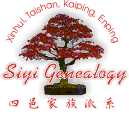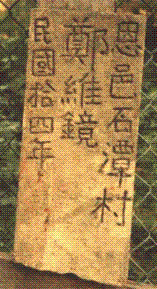

This article is written by Corinne Pratz, appears here courtesy of the Cowichan Valley Historical Preservation Society.
 The discovery of a Chinese grave marker at the Youbou millsite has the future plans for this area up in the air.
The discovery of a Chinese grave marker at the Youbou millsite has the future plans for this area up in the air.
Former mill workers reported seeing the marker and pictures were taken. The last sighting before the recent find dates back to 1987. However, the carved stone has remained in tact. Translated by Dr. Hua Lin at the University of Victoria, the marker reads: Zheng Weijing, (from) En Yi Shi Tan Cun, 1925.
In 1925, Youbou was not yet established. A small mill operation called, Medina on Cottonwood Creek processed timber amidst a small community named Yap Alley. Immigrants from Europe, Asia, America and India worked to clear virgin land and create settlements.
Racial tension was high during this period, especially for the Chinese. The promise of gold and better living during the late 1800's had brought the Chinese people in droves. Initially, the hard laboring ethics of the Chinese was appreciated by most. Hundreds of workers were recruited from China by Island companies seeking cheap labor. There was plenty of work to be had for everyone and the Chinese immigrants built the CPR that brought the greatest economic shift on the Island. Others worked as laundry and domestic help. But that was not to last very long.
Anti-Chinese Riots occurred at work sites and in newly formed cities. Chinese people were killed, homes were destroyed and many perished from the inhumane circumstances they were forced to live under. The formation of the Anti-Chinese Society in 1873, brought considerable pressure to government legislation.
BC archives report earnings that demonstrate the prejudism of the time. A Chinese worker could make 9 cents a day, an East Indian 12 cents and a white worker 55 cents for much the same labor.
The government took strong action against further Chinese immigration through required head tax increases. The Chinese were the only immigrants that were required to pay this tax to the government. By 1904, the amount had jumped from $50 in 1885 to $500. This determent greatly affected the number of Chinese immigrants. However, by 1923, the Exclusion Act passed in BC prohibited any Chinese from entering the country. Those who lived here could leave but were forced to return within a specific period of time as determined by authorities or they would not be allowed to return. The impact on the Chinese was devastating. Dreams of returning home with money or of bringing wives, children and other family over to Canada to built a new life were destroyed. Many did not see their spouses or children for over a decade. Many more committed suicide.
Local legend surrounding the grave marker found at Youbou tell of a man who met with such a fate. It is told by Youbou resident, Gary Lavoie, that Zheng Weijing hung himself from a Maple Tree. Lavoie's father, now passed away, layed claim to witnessing the grisly find. He went on to say that the Chinese workers at the site banded together and refused to work until the entire tree had been cut down.
According to Rosemary Crawford in an article written for The Old Cemeteries Society Newsletter, Winter 2001 issue, treatment of the dead was meticulous:
"...traditional beliefs and rituals had been brought with the Chinese from their homeland. In earlier days most Chinese believed the soul stayed in the bones after death, and therefore it was extremely important that the remains be handled according to strict tradition.
The dead were buried in shallow, temporary graves; then after seven years the body would be exhumed and the bones cleaned and placed in a small wooden box with the name of the deceased and his or her village painted on the box."
Whether Zheng Weijing's body was treated according to this tradition or not is unknown at this time. Timberwest, owner of the land where the grave marker is located has roped off the immediate area surrounding the site.
Initiatives pertaining to the preservation of this area and the surrounding area have commenced. Local area residents are writing letters to Timberwest executive and to the BC government in an appeal to the proper treatment of the section of land where the marker is located. Reports of other grave markers as well as many artifacts found on the site has fueled the communities' insistence.
John Waddington, Youbou resident wrote, "It has been brought to my attention that a Chinese grave site has been discovered on the Timberwest sawmill site in Youbou. As a member of this community I would like to see the Entire Chinese Bunkhouse area and Grave Site set aside and donated to Youbou as a Historical Monument, to commemorate the Chinese people who gave their lives to help build our community as well as others throughout BC.
Proper treatment for "Zhang Weijing", from the village of "En Yi Shi Tan Cun" who's grave has been left to the weeds and scrap iron on the Timberwest site is imperative."
Following a series of discussions on this area, Timberwest Executive, Don McMullan had this to say about Timberwest's plans:
"Decommissioning works, primarily foundation removal, will likely carry through into 2002. Once the foundations are removed, we will undertake a Level 2 environmental assessment and will have it completed by the end of 2002."
As it now stands, it seems reasonable to expect that we would be in a position to develop a managed and coordinated approach for assessing the site for historical values sometime in 2002."
Steve Lorimer of Timberwest reports that the Cemetery and Funeral Services Branch has been contacted and that the company intends to adhere to all legislation concerning the area.
Historical preservation organizers ask that you contact them at 250-749-4973 for further information on the Youbou area initiatives or in the event that you have materials or information relevant to Chinese Immigration in Cowichan Valley.
©Corinne Pratz
June 2001